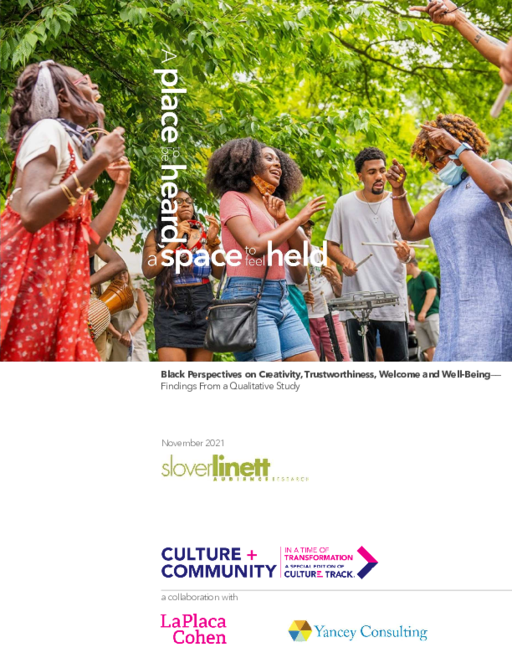Breadcrumb
- Wallace
- Reports
- A Place To Be Heard; A Space To ...
A Place to be Heard; a Space to Feel Held
Black Perspectives on Creativity, Trustworthiness, Welcome and Well-Being–Findings from a Qualitative Study

- Author(s)
- Melody Buyukozer Dawkins, Ciara K. Knight, Tanya Treptow, and Camila Guerrero
- Publisher(s)
- Slover Linett Audience Research, LaPlaca Cohen, and Yancey Consulting
Summary
How we did this
The researchers interviewed 50 Black Americans from diverse multiracial, multiethnic, immigrant, and LGBTQIA+ communities. Participants came from suburban, urban, and rural areas, and ranged in age from 20 to 76. The group spanned different levels of participation and skill in the arts. Interviews took 90 minutes.
This report seeks to understand how arts and culture organizations can better serve Black communities and nurture their involvement in arts and culture.
It was issued as part of a national initiative to bridge the cultural sector to the experiences and needs of communities during the Covid pandemic and beyond. The researchers aim to create a picture of how Black Americans participate in arts and culture. They also suggest ways arts and culture organizations can be more welcoming to Black Americans.
The researchers carried out phone and online interviews with 50 Black Americans. The research team acknowledges that the view of this group cannot represent the full spectrum of attitudes among Black Americans across the country. But they did find common threads that suggest the importance of four key practices for arts and culture organizations seeking to create a more positive environment for Black audiences:
- Celebrating personal and community creativity
- Supporting self-care
- Working to be more trustworthy
- Creating a sense of welcome and belonging.
Understanding these practices could help arts organizations build stronger relationships with Black communities, the researchers suggest. They recommend that organizations challenge themselves to:
- Focus on the personal relationships created by arts experiences
- Provide fuller depictions of Black humanity by offering artistic expressions of Black joy, innovation, leisure, and brilliance
- Expand the definition of creativity to include moments of “everyday creativity”—recognizing that all kinds of arts are important
- Earn trust and build credibility with the Black community by offering consistent support when the community has urgent needs
- Be welcoming through small acts of kindness and letting people express themselves authentically.
Key Takeaways
- Working on four practices—creativity, self-care, trustworthiness, and welcome—could lead arts and culture organizations to better connection with Black communities.
- Participants in the study valued creativity and self-expression in their lives, even if not all saw themselves as creative or artistic.
- Arts organizations could support individual and community healing and well-being by providing safe, accessible spaces for artists.
- Arts organizations often focus on Black trauma and experiences of injustice instead of Black success and innovation, which would help to show shared humanity and common experiences.
- Organizations could make Black people feel welcome through small acts of kindness and examining visible and invisible cues in their space. For example, if an organization fails to have Black employees at higher levels, this sends a message of unwelcomeness.
Visualizations

Materials & Downloads
What We Don't Know
- What would it look like for a diversity of Black experiences to be expressed in different arts organizations?
- What strategies could be used by arts organizations to celebrate Black artists?

